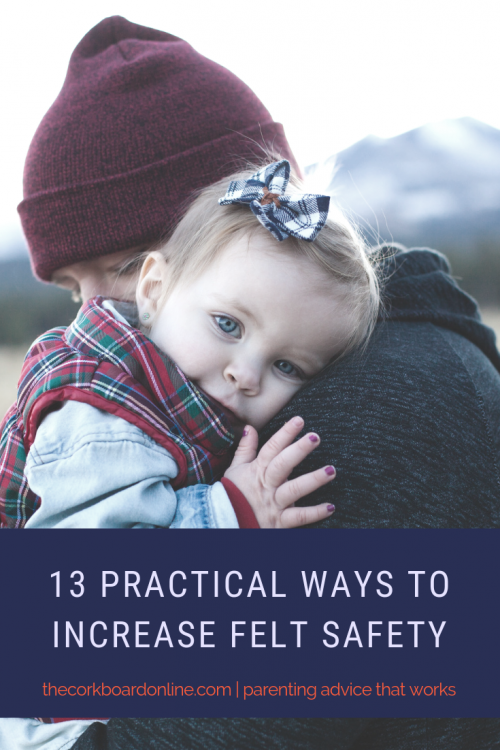Lack of felt safety is one of the five reasons kids misbehave. So what is felt safety? Our nervous systems have an instinct called “neuroception.” This is how we unconsciously distinguish whether situations or people are safe, dangerous, or life-threatening. When our kids have experienced chronic stress or have differences in their brain function, like ADHD, their neuroception can be inaccurate.

Because their nervous system is telling them they are in danger, their reactions to situations may seem inappropriate or extreme.
Here are 13 things you can do to help your child’s nervous system feel safer.
[bctt tweet=”Here are 13 things you can do to help your child’s nervous system feel safer. #parenthacks” username=”corkboardblog”]
1. Be attuned to your child. Pay attention to non-verbal signs that your child is not feeling safe, so you can help out before it’s a full-blown meltdown.
2. Name it to tame it. It’s unlikely that your child will come out and say, “I’m not feeling safe.” They need you to narrate what you’re seeing. Just because they automatically deny it, doesn’t mean you’re wrong, but it’s also important to not get into a control battle.
3. Give voice. Be willing to hear your child out, even if you don’t agree to what he’s saying, or it makes you feel uncomfortable.
4. Validate emotions. You might not understand where they’re coming from, but it’s important to validate their emotions. A lot of situations register as traumatic for people because they felt alone in the experience.
5. Offer appropriate control. Whenever possible, offer choices or allow your child to ask for a compromise. We have more felt safety when we’re in control. This is also part of giving voice.
6. Match arousal energy in a controlled way. If your child is upset and his energy is high, mirror his enthusiasm but remain in control. Think of yourself as an Oscar-winning actor. This mirroring helps your child know that they are not alone. They know you see them which helps regulate their frightened nervous system.
7. Stay playful. Playfulness is definitely like a muscle. It can get stronger, but it can also atrophy. For me, the more stressed I am, the weaker my play muscle gets. However, playfulness helps keep a situation from escalating by keeping the nervous system open. The simplest example is mouthiness. It tends to be triggering for us, so we can respond with a stern, “do NOT speak to me that way!” or we could use a more playful phrase, “Are you askin’ or tellin’?”
8. Remain curious. I’ll speak for myself, but I have a tendency to jump to conclusions, and usually I’m assuming the worst about my kid. Be careful. This can become a self-fulfilling prophecy for our kids if they feel like we’re always expecting the worst. Curiosity helps to keep the nervous system from shutting down and becoming defensive.
9. Be consistent. The unknown can feel scary. Our kids need to see us as stable and predictable.
10. Keep it concrete. Kids with brain differences usually struggle with abstract concepts. Use tools that help them touch, feel, and experience something rather than just hear about it. This will help them feel more capable of learning which will help them feel more secure.
11. Less is more. Fewer words, less clutter, less on the schedule. Our kids are working so much harder than to keep up. We can lighten their load by giving them less to keep up with.
12. Speak your child’s Love Language. I know not everyone is familiar with love languages. It’s the idea that we all receive and give love in different ways. This is important to recognize because if we give love in one language but our kids receive in another, they may not feel loved or safe. Click here to take a Love Language quiz.
13. Safe and Sound Protocol. Consider a listening intervention called the Safe and Sound protocol. Developed by Dr. Stephen Porges, the Safe and Sound Protocol (SSP) is a five-day auditory intervention. It’s designed to reduce stress and auditory sensitivity while enhancing social engagement and resilience. Based on Dr. Porges’ Polyvagal Theory, SSP calms the physiological and emotional state. Then, the door is opened for improved communication and more success with other therapy modalities.
For more info or to find out if this is a good fit for your child, click here.




